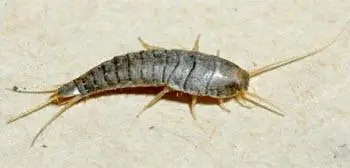[Photo by Comtesse DeSpair]
There is nothing more offensive than an infestation. A year and a half ago, me and my man found ourselves living with termites. Have you ever seen a termite hatch (or awakening, or whatever in the hell it's called)? All their little babies hear the siren call of spring and emerge from hiding places you didn't know existed and march like lemmings toward the sun. Or your drapes — whatever comes first. The sight could definitely create a long-lasting phobia, as I think it did in my husband.
Pests in general are disturbing because they represent a loss of control over your own environment, and your environment includes things you love. Things like, oh I don't know, books.
Most people neglect their books. They choose them with such care and then relegate them to dirty bookshelves they don't dust. Not ever wiping down your kitchen counters seems wrong, but it's par for the course for your bookshelves. It's nasty when you think about it, right? What's worse are the disgusting friends your books have made in the meantime.
People collect a lot of stuff, just as libraries do. Books, photographs, LPs, newspapers, vintage Playboy magazines — collections come in all varieties. Every collection is special to its owner, some for volume, others for distinct items. The important thing to remember here is pests are equal opportunists; it all tastes good to them, and they don't care how much you paid for it.
It goes without saying (but I'll say it anyway) that if you have mice, rats, cockroaches, or termites already established in your home, then they have been snacking on your collections. Call the exterminator and do what needs to be done. We did and now we can sleep at night. What I want to direct your attention to are two lesser-known evils that plague libraries everywhere, make archivists cry, and may be living with your collections right now. They are: silverfish and mold.
The Mighty Silverfish
Silverfish sounds like a beautiful mermaid relative, but in reality is a primitive wingless insect with two antennae and three antennae-looking "tail projections." Adults reach up to ¾ inch, so they're easy to miss. Silverfish thrive in humid places. They prefer heat, but archival expert Susan Luftschein tells me she has found them in all possible environments — hot, cold, wet, and dry. They can live for up to a year without food. They eat everything a library has to offer: paper, the glue in book bindings, even ink. Telltale signs of silverfish include book covers and pages mottled with holes and droppings around the food source.
Gross! If your whole house is crawling with silverfish, bombing is the only way to completely eradicate them. If the problem is relatively minor, you can set out some Dekko Silverfish Paks, which are tempting paper and glue treats laced with boric acid. The silverfish nibble at the Paks, then go away and die. Over a few weeks, you should see more dead silverfish and less droppings. Regardless of how you choose to deal with them, any evidence of silverfish warrants a thorough cleaning. Also, if you find silverfish inside any of your books, put them in a bag you can seal, then leave them in your freezer for a few days. Freezing kills silverfish and won't hurt your books.
Mold, the Great and Powerful
Mold strikes when materials get wet and don't dry out completely. It's very easy for this to happen in a basement or if your materials are up against an exterior wall. As we all know, mold is bad for your health, so you should take any sign of mold in your collections seriously. Mold can grow on just about anything, even CDs, and it ruins the surfaces on which it grows. When it's active and alive, mold is fuzzy and springy. Dead mold is often black and flakes off easily.
Any materials found with mold should be immediately segregated from the rest of the collection and treated. Now, before you start probing the bits of mold you found in your house, take a few precautions! You'll want to wear gloves and a face mask to protect you from spores released from the mold. If feasible, take the infected items outside. At the very least, work in a well-ventilated room. Wet pages should be interleaved with paper towels and left open to dry, preferably in the sun. Individual pages or other surfaces (like LPs) infected with mold should be gently wiped off with a damp cloth. If you discover that mold has overtaken something in your collection, consider photocopying it and then tossing it.
A Note on Cleaning
Now that we've gone over all the nasties, let's talk about preventative maintenance. Michaela Ullmann, Exile Studies Librarian at USC, gave me the Cinderella tour of the Villa Aurora once, where she taught me how to properly clean a book collection. Here's what you do:
1. Remove each book from the shelf and dust with a damp cloth.
2. Fan the pages to release the dust.
3. Use a soft paintbrush to dust the top and fore edge of each book.
4. Wipe the bookshelf down with a damp cloth.
Repeat until all your books are clean.
A thorough cleaning twice a year will keep your collection happy and enable you to treat infestations before they become a huge problem. Between major cleanings, Sue Luftschein recommends cleaning your bookshelves and the tops of your books with a Swiffer duster. Easy, right?
Finally, pay attention to the things you bring into your home. Love shopping at used bookstores and flea markets? Quarantine your purchases before adding them to your collections. A few days spent in a sealable bag in your freezer will kill off any critters or active mold you may have picked up. And of course, thoroughly wipe down new items before filing them on your sparkly clean bookshelf.

About the author
Stephanie Bonjack is an academic librarian and musician who lives and works on the Colorado Front Range. She teaches the relentless pursuit of information, and illuminates the path to discovery. She has presented at national and international library conferences, and is especially interested in how libraries evolve to serve the needs of 21st century patrons.








